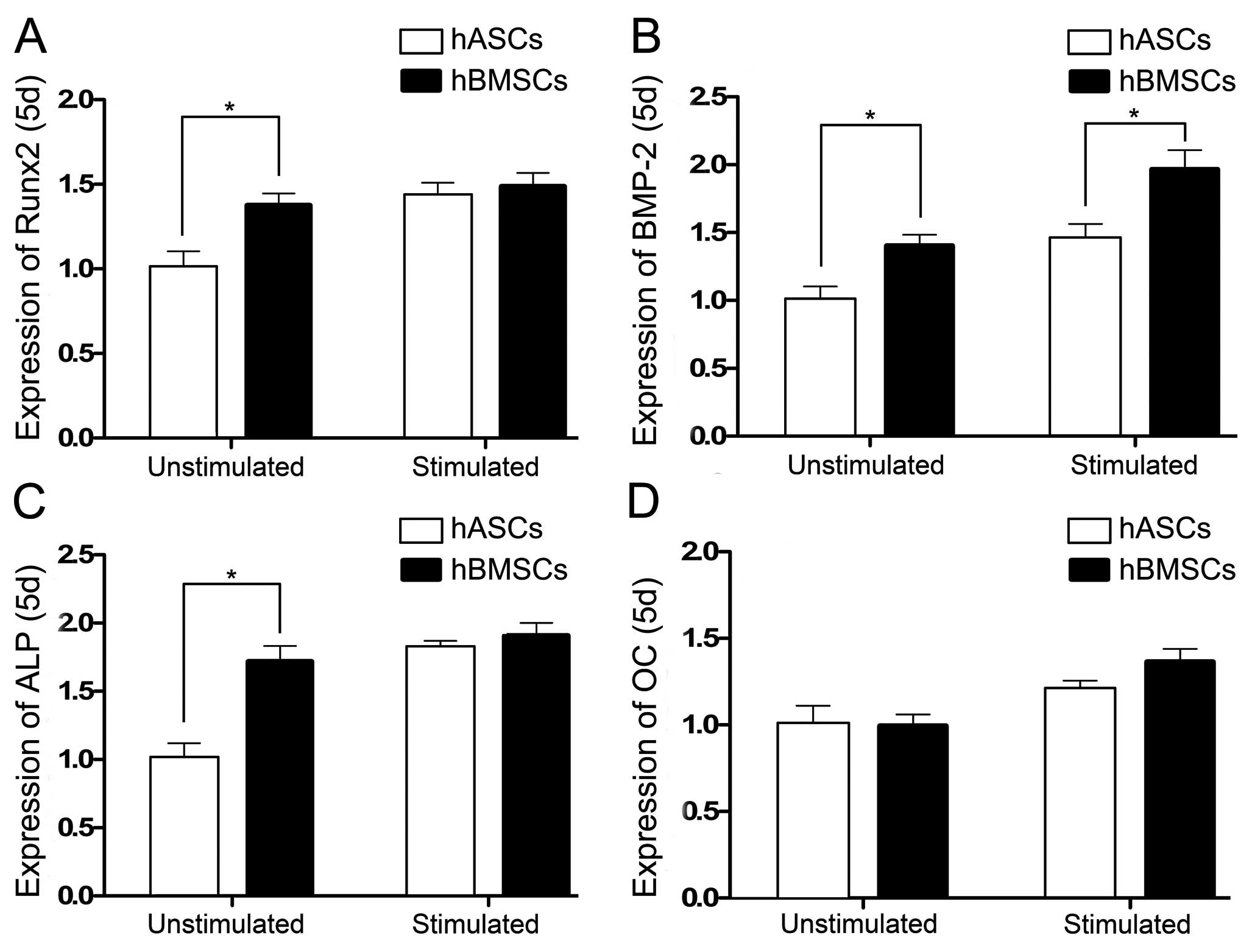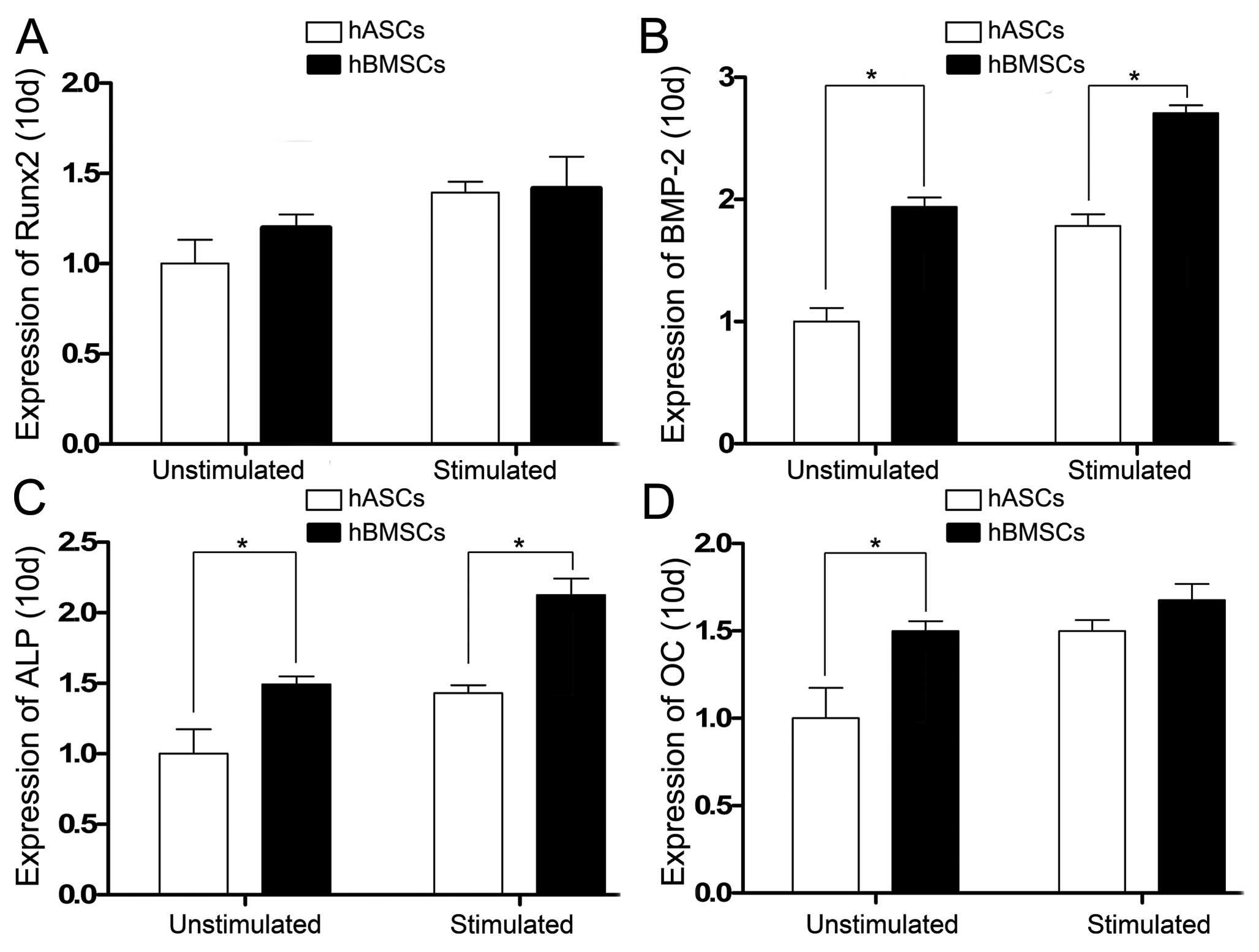|
1.
|
E PotierJ NoaillyK ItoDirecting bone
marrow-derived stromal cell function with mechanicsJ
Biomech43807817201010.1016/j.jbiomech.2009.11.01919962149
|
|
2.
|
C XiaoH ZhouS GeRepair of orbital wall
defects using biocoral scaffolds combined with bone marrow stem
cells enhanced by human bone morphogenetic protein-2 in a canine
modelInt J Mol Med26517525201020818491
|
|
3.
|
NA AritaD PelaezHS CheungActivation of the
extracellular signal-regulated kinases 1 and 2 (ERK1/2) is needed
for the TGFbeta-induced chondrogenic and osteogenic differentiation
of mesenchymal stem cellsBiochem Biophys Res
Commun405564569201110.1016/j.bbrc.2011.01.068
|
|
4.
|
JC BodleAD HansonEG LoboaAdipose-derived
stem cells in functional bone tissue engineering: lessons from bone
mechanobiologyTissue Eng Part B
Rev17195211201110.1089/ten.teb.2010.073821338267
|
|
5.
|
NJ PanettaDM GuptaJK LeeDC WanGW CommonsMT
LongakerHuman adipose-derived stromal cells respond to and
elaborate bone morphogenetic protein-2 during in vitro osteogenic
differentiationPlast Reconstr
Surg125483493201010.1097/PRS.0b013e3181c82d75
|
|
6.
|
H TappEJ HanleyJC PattHE
GruberAdipose-derived stem cells: characterization and current
application in orthopaedic tissue repairExp Biol Med
(Maywood)23419200910.3181/0805-MR-17019109553
|
|
7.
|
G LiuY ChengS GuoTransplantation of
adipose-derived stem cells for peripheral nerve repairInt J Mol
Med28565572201121687931
|
|
8.
|
DA De UgarteK MorizonoA
ElbarbaryComparison of multi-lineage cells from human adipose
tissue and bone marrowCells Tissues Organs174101109200312835573
|
|
9.
|
H HattoriM SatoK MasuokaOsteogenic
potential of human adipose tissue-derived stromal cells as an
alternative stem cell sourceCells Tissues
Organs178212200415550755
|
|
10.
|
GI ImYW ShinKB LeeDo adipose
tissue-derived mesenchymal stem cells have the same osteogenic and
chondrogenic potential as bone marrow-derived cells?Osteoarthritis
Cartilage13845853200510.1016/j.joca.2005.05.00516129630
|
|
11.
|
R VishnubalajiM Al-NbaheenB KadalmaniA
AldahmashT RameshComparative investigation of the differentiation
capability of bone-marrow- and adipose-derived mesenchymal stem
cells by qualitative and quantitative analysisCell Tissue
Res347419427201210.1007/s00441-011-1306-322287041
|
|
12.
|
S GhazanfariM Tafazzoli-ShadpourMA
ShokrgozarEffects of cyclic stretch on proliferation of mesenchymal
stem cells and their differentiation to smooth muscle cellsBiochem
Biophys Res
Commun388601605200910.1016/j.bbrc.2009.08.07219695226
|
|
13.
|
F ColazzoP SarathchandraRT
SmolenskiExtracellular matrix production by adipose-derived stem
cells: implications for heart valve tissue
engineeringBiomaterials32119127201110.1016/j.biomaterials.2010.09.00321074262
|
|
14.
|
CE SarrafWR OttoM EastwoodIn vitro
mesenchymal stem cell differentiation after mechanical
stimulationCell
Prolif4499108201110.1111/j.1365-2184.2010.00740.x21199014
|
|
15.
|
RD SumanasingheSH BernackiEG
LoboaOsteogenic differentiation of human mesenchymal stem cells in
collagen matrices: effect of uniaxial cyclic tensile strain on bone
morphogenetic protein (BMP-2) mRNA expressionTissue
Eng1234593465200610.1089/ten.2006.12.3459
|
|
16.
|
Z Goli-MalekabadiM Tafazzoli-ShadpourM
RabbaniM JanmalekiEffect of uniaxial stretch on morphology and
cytoskeleton of human mesenchymal stem cells: static vsdynamic
loading Biomed Tech
(Berl)56259265201110.1515/BMT.2011.10921988158
|
|
17.
|
OH LowryNJ RosebroughAL FarrRJ
RandallProtein measurement with the Folin phenol reagentJ Biol
Chem193265275195114907713
|
|
18.
|
HA ElSH CartmellBioreactors for bone
tissue engineeringProc Inst Mech Eng
H22415231532201010.1243/09544119JEIM80221287835
|
|
19.
|
L TirkkonenH HalonenJ HyttinenThe effects
of vibration loading on adipose stem cell number, viability and
differentiation towards bone-forming cellsJ R Soc
Interface817361747201110.1098/rsif.2011.021121613288
|
|
20.
|
M DominiciK Le BlancI MuellerMinimal
criteria for defining multipotent mesenchymal stromal cells. The
International Society for Cellular Therapy position
statementCytotherapy8315317200610.1080/14653240600855905
|
|
21.
|
JB MitchellK McIntoshS
ZvonicImmunophenotype of human adipose-derived cells: temporal
changes in stromal-associated and stem cell-associated markersStem
Cells24376385200610.1634/stemcells.2005-023416322640
|
|
22.
|
MN KangHH YoonYK SeoJK ParkEffect of
mechanical stimulation on the differentiation of cord stem
cellsConnect Tissue
Res53149159201210.3109/03008207.2011.61928422149641
|
|
23.
|
F OttoAP ThornellT CromptonCbfa1, a
candidate gene for cleidocranial dysplasia syndrome, is essential
for osteoblast differentiation and bone
developmentCell89765771199710.1016/S0092-8674(00)80259-79182764
|
|
24.
|
C ColnotCell sources for bone tissue
engineering: insights from basic scienceTissue Eng Part B
Rev17449457201121902612
|
|
25.
|
RT FranceschiBS IyerRelationship between
collagen synthesis and expression of the osteoblast phenotype in
MC3T3-E1 cellsJ Bone Miner
Res7235246199210.1002/jbmr.56500702161373931
|















